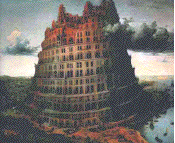Mythical Towers

Although orbital towers appear futuristic, it is perhaps worth noting that towers which reached the sky abound in human myth and legend.
In the West, the most famous of these is the Tower of Babel, recorded in Genesis:
'Come,' they said, 'let us build ourselves a city and a tower with its top in the heavens, and make a name for ourselves, or we shall be dispersed all over the earth.' Then the Lord came down to see the city and tower that which mortal men had built, and he said, 'Here they are, one people with a single language, and now they have started to do this; henceforward nothing they have a mind to do will be beyond their reach..' (NEB Genesis 11)
The Book of Genesis also offers Jacob's Ladder:
..(Jacob) came to a certain place and stopped there for the night because the sun had set; and, taking one of the stones there, made it a pillow for his head and lay down to sleep. He dreamt that he saw a ladder, which rested on the ground with its top reaching to heaven, and angels of God were going up and down on it.. (NEB Genesis 28:11)
The Egyptian Pyramid Texts refer to a ladder by which the dead pharaoh ascended into the sky:
The gods who are in the sky are brought to you, the gods who are on earth assemble for you, they place their hands under you, they make a ladder for you that you may ascend on it into the sky, the doors of the sky are thrown open to you, the doors of the starry firmament are thrown open to you. (Ancient Egyptian Pyramid Texts, Utterance 572)
This ladder appears to have extended down from heaven to earth as a rope-ladder:
Atum has done what what he said he would do for this king; he ties the rope ladder for him. (Ancient Egyptian Pyramid Texts, Utterance 688)
The Pyramid texts are among the most ancient of Egyptian texts, and are inside the ruined pyramid of the pharaoh Unas, and are concerned with the preparation of his ascent to the stars.
O my mother, the wild cow which is upon the mountain of p--- and the mountain of the zh-zh-bird, the two dj-d pillars stand, though the broken rubble(?) has fallen, and I ascend on this ladder which my father Re made for me.. (utterance 271)
I ascend the thighs of Isis. I climb up on the thighs of Nephthys.(utterance 269)
The dj-d pillar of the Day-bark is released for its lord, the dj-d pillar of the Day-bark is released for its protector. Isis comes and Nephthys comes, one of them from the west, and one of them from the east... (utterance 532)
O sounding-poles of Horus, O wings of Thoth, ferry me across, do not leave me boatless. Give me bread, give me beer, from this your bread of eternity, from this your beer of everlasting, for I am he who belongs to the two obelisks of Re which are on earth, and I belong to the two sphinxes of Re which are in the sky. (utterance 515)
Elsewhere, the tower is replaced by a tree that reaches to heaven. In Norse mythology there is Yggdrasil, the World Ash Tree, which reaches heaven. In Mayan myth, the universe was divided into 3 zones - heaven, earth, underworld - In the centre of the world stood the Tree of Life which connected the heavens with the underworld. The souls of the dead ascended through the roots of the tree and climbed to reach the heavens above.
"The cosmic tree of the Upanishads (The Katha-Upanishad cites: "This eternal Ashvattha, whose roots ascend and whose roots reach down, is the pure, is the Brahma; the Brahma is the one that is named the non death", my note)... stretches its roots in the sky and stretches its branches on earth. The image of the upside down tree can be found in the sabea tradition (yemenite civilization, V.th-I.st cent. b.C, my note), in the sepharoth esoterism, in Islam, in Dante as well as in certain rites of the laps, australians and islanders. "(7)
(7) Gilbert Durand, Les structures anthropologiques de l'Imaginaire , P.U.de France, 1963, it.tr. Le strutture antropologfiche dell'immaginario , Dedalo, Bari, 1963 p.347 (back)
A few other related stories and images may be included. There is the folk-tale of Jack and the Beanstalk, which Jack climbs to enter a land inhabited by a man-eating giant. The Tarot, of uncertain antiquity, has Card 16, The Lightning-Struck Tower, signifying ambition and catastrophe. Also the fabled Indian rope trick: a rope is thrown upwards, and an armed man climbs up it, and engages in an unseen battle, during which parts of limbs drop to ground.